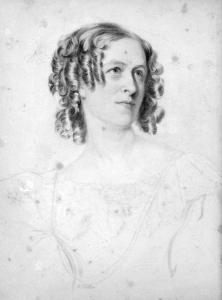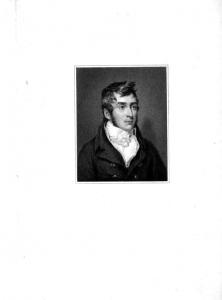Life of Thomas Stothard RA with Personal Reminiscences by Mrs Bray
Life of Thomas Stothard RA with Personal Reminiscences by Mrs Bray is in Victorian Books.
LIFE OF THOMAS STOTHARD, R.A WITH PERSONAL REMINISCENCES By MRS. BRAY (age 60), Author of "The Borders of the Tamar and the Tary", "Memoirs of Charles A. Stothard, F.S.A", "Trelawny", "Trials of the Heart," &c.,&c.
WITH NUMEROUS ILLUSTRATIONS FROM HIS WORKS.
LONDON: JOHN MURRAY, ALBEMARLE STREET. 1851.
BRADBURY AND EVANS, PRINTERS EXTRAORDINARY TO THE QUEEN, WHITEFRIARS.
 Portrait of Anna Eliza Kempe.
Portrait of Anna Eliza Kempe.
 ADVERTISEMENT
ADVERTISEMENT
IN the year 1836, two articles of mine, entitled "Reminiscences of Stothard," were published in the May and June numbers of Blackwood's Magazine. In 1845, Mr. Alfred Stothard, son of the late hisstorical painter, and himself a medallist of great ability, passed some little time with us at Tavistock. During his visit, he expressed his regret that he had not been made acquainted with my intention to write the articles on his father, as he could have furnished me with some additional information. These, therefore, I revised, corrected, and re-modelled; and embodied in them not only the particulars I received from so authentic a source, but added alfo many from my own recollections; till at length, the work grew so much upon me, that I determined to throw it into a more biographical form.
After I had thus enlarged and completed my talk, it was fuggefted to me by Mr. Murray, that it would be defirable, if possible, to obtain fome original letters of Stothard. In the hope of being enabled to do this, I applied to Mr. Alfred Stothard, who kindly lent all the papers he had of his late father. Thefe principally confifted of letters to and from his wife; with fome rude drafts of others to various perfons on matters of bufinefs connected with his profeffion; and two very briefly written diaries of journeys to Edinburgh and Derby mire, whilft engaged in his purfuits. All thefe documents I moft carefully examined.
I found the letters addrefTed to Mrs. Stothard evinced kind and good feelings as a hufband and a father; but, for the greater part, so much were they of a private nature, as to contain little information for the public. From thefe, therefore, I felected only a few extracts, to mow how ftrong were his domeftic affections.
Refpecting letters and papers of a more general or profeflional character, I grieve to fay, I could find but few that were in a ftate for publication, or would have pofTefTed any intereft with the reader. Moft of them were fragments, unfinifhed drafts, or rude memoranda, and ufually without dates; fome with so many obliterations, and in so imperfect a ftate, that they could not be clearly understood, and thus were ufelefs. I have, therefore, been compelled to give but very few.
In juftice to myfelf I have ftated this; as it will, in fome meafure, account for a want of exact regularity as to the order in which they are placed. Indeed, I have frequently felt the difficulty, in fome inftances the impoftibility, of following the principal events of Stothard's life in ftricl: chronological order. Thofe who were moft intimately acquainted with the early part of his career are no longer living; and, from natural modefty and referve, he feldom, if ever, talked about himfelf.
The plan of giving illuftrations from the works of a great painter, with fome account of his life, originated with Mr. Leflie, R.A., in his Memoirs of Conftable; Mr. Murray has, in fome meafure, adopted it as the precedent and example in the ftyle of illuftrating the prefent volume. To that eminent artift I am indebted for two or three characteriftic anecdotes of his brother Academician, and for the extract from a ledlure which he recently delivered at the Royal Academy refpecting the productions of Stothard's pencil.
To Mr. Carpenter, of the Britifh Mufeum, my thanks are due for his great kindnefs and attention in enabling me to profit by the engravings from the works of Stothard, under his care, in the print- room of that National Inftitution. To Mifs Denman, Mr. Rogers, and Mr. Windus, I am alfo indebted for having moft obligingly allowed fome of his defigns, in their pofleflion, to be copied for thefe pages.
ANNA ELIZA BRAY (age 60).
The Vicarage, Tavistock, November, 1851
Victorian Books, Life of Thomas Stothard RA with Personal Reminiscences by Mrs Bray, Chapter 1
Parentage and Birth of Stothard — Sent to nurfe at Acomb — The old ftore-room and its attraction — Brought to London; placed at fchool — His father dies — Apprenticed to a pattern draftlinan — Defigns from Homer and Spenfer — His mafter dies — He continues with the widow— Makes (ketches for her — Two gentlemen call on her — Remits of the meeting — His early friends — Apprenticelhip expires — Employed on the Novelift's Magazine — Exhibits his first picture — Becomes a ftudent in Maiden Lane — His love of literature — Rambles in North Wales — Sketches from nature — Boating excurfion — Falls in love — Marries — Alderman Boydell — Goes to a Manfion Houfe Ball — Elected an Aflbciate of the Royal Academy — His progrefs and works.
THE father of Thomas Stothard was a native of Stutton, near Tadcafter, in Yorkfhire; and though of an old and good family, so much reduced in circumftances, that (like the father of Sir Thomas Lawrence) he followed no higher calling than keeper of an inn. His wife, whofe maiden name, I believe, was Reynolds, was a native of Shrews- bury; highly refpeclable both in her family and connexions. In 1750, they removed to London; where, during the few years that the elder Stothard lived, he carried on his bufinefs in Long Acre, with considerable fuccefs; so that at his death he was enabled to leave fome provifion for his family.
His only child, Thomas, was born in London on the 17th of Auguft, 17551 In a biographical fketch where, like the prefent, the fubject of it is more endowed by nature than diftinguifhed by birth, it is often attempted (though not always very fatisfactorily) to raife him by a reference to the dignity of his anceftors. In this inftance, however, there is no need to have recourfe either to fancy or tradition, in order to bring our artifl: within the pale of gentle blood and honourable lineage, as the following facts will atteft.
Note 1. A doubt exifted respecting the birth-place of Stothard; as fome of his family believed it was Acomb, near York: the queftion has been fet at relt by Mr. Peter Cunningham, who took the trouble to fearch the regifters of St. Martin's-in-the-Fields, the parifh in which the greater part of Long Acre lies. There he found the entry of Stothard's birth and baptifm. With a copy of this, he had the kindnefs to fend me fome few interefting memoranda concerning the childhood of Stothard, which his father, the late Mr. Allan Cunningham, made on the 6th of July 1830, being the day he received such information from Stothard himfelf. In the Britifh Mufeum two documents are preferved refpefting him; one of them is nothing more than a flip of paper, on which he wrote a few particulars of his early life, at the requeft of the late Mr. Balmanno, in 1829, and in which, from failure of memory at so advanced an age, (being then in his feventy-fixth year) he made fome flight errors and omiflions. The other document is a short account of him that appeared in fome magazine feveral years ago, to a copy of which Stothard annexed corrections and additions on the margin; in the latter were a few particulars not ftated by him to Mr. Allan Cunningham; and also a few discrepancies, but not of so material a nature as to require
On a failure of heirs male, in a not very diftant branch, Thomas Stothard ftood as the heir-at-law to an old family manfion and a large landed property, I believe, in Gloucefterfhire. Many years ago that failure took place, and he was advifed to assert his claims, and take the ufual legal meafures in such a cafe. But he not only felt a great repugnance to difturb the tranquillity of his own mind, and the delightful indulgence of his imagination at the easel, with the turmoil and hazard and vexatious delays of a lawfuit, but a generous motive alfo prevailed with him; as, at the time he was so much urged to proceed in the affair, he remarked, with the accuftomed Simplicity of his character, "that he mould not like to difturb with law the three maiden ladies who had the property in pofTeffion." Burke would not have faid that a fpirit of chivalry was dead in England, could he have heard this anecdote of Stothard. To return from this digreffion.
[Note. Thomas Stothard's mother was Mary, one of three nieces and heiresses of Danvers Hodges who owned Broadwell House, Gloucestershire]
Thomas being a delicate child, his father, anxious about his health, fent him, when five years old, to his uncle at York, who placed him "under the care of an old lady, a good woman and a ftaunch prefbyterian." She lived in the little village of Acomb, near that city. "There," faid Stothard, "I grew ftronger. She had two fons in the Temple, London, who fent her a prefent of fome of the heads of Houbraken, framed and glazed; likewife an engraving of the blind Belifarius, by Strange; and fome religious pictures from the unrivalled graver of the fame artift. I looked often and earnestly at thofe productions; for the old lady admitted me freely into her room, and feemed pleafed with my admiration of them. I gazed till a love of Art grew within me, and a defire to imitate what was on her walls. I got bits of paper and pencils, and made many attempts. I could fee that my hand was improving, and I had fketched fome things not amifs, when, at eight years old, I was removed to Stutton, the birth-place of my father. Before this, I mould have mentioned that my father, pleafed with my attempts, had fent me boxes of colours, which I knew so little how to ufe, that I applied to a houfe-painter for fome mixed paint, which he gave me in an oyster-mell, and the first man I painted was in black. I had no examples; you know how neceflary they are; Literature may be taught by words, Art muft come through figns." Such was the account given by this eminent man concerning his childhood, to Mr. Allan Cunningham, in 1830. The following circumstances refpecting an old picture which alfo made a Strong impreffion on Stothard's infant mind, whilft at Acomb, were communicated to me by his fon Alfred, who allured me that he received them from his father's own lips. They probably occurred at an earlier period than that of the prefent of the engravings to the old lady, which he attempted to "imitate," or copy.
It appears that Stothard's nurfe at Acomb was a widow, named Stainburn1, who lived in an antiquated farm-houfe, and kept a day-fchool to aid her fmall means.
Note 1. Her name is ftated by Stothard in his marginal notes in the old magazine. May not his recolleftions of the good widow of Acomb, and her day-fchool of little rustics, have been depicted in one of his very early and beautiful designs (which was engraved) from Shenstone's Schoolmistress?